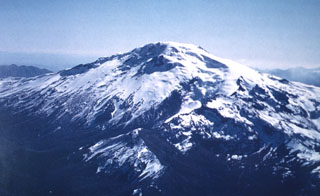Report on Callaqui (Chile) — March 1997
Bulletin of the Global Volcanism Network, vol. 22, no. 3 (March 1997)
Managing Editor: Richard Wunderman.
Callaqui (Chile) Continuous fumarolic activity at main vent and upper S flank
Please cite this report as:
Global Volcanism Program, 1997. Report on Callaqui (Chile) (Wunderman, R., ed.). Bulletin of the Global Volcanism Network, 22:3. Smithsonian Institution. https://doi.org/10.5479/si.GVP.BGVN199703-357091
Callaqui
Chile
37.92°S, 71.45°W; summit elev. 3164 m
All times are local (unless otherwise noted)
A late-March overflight made after a prolonged dry season enabled views of Callaqui with relatively low snow levels. At the time of the overflight, the main vent at the summit showed vigorous steam emissions and sulfur deposits were noted around the two main fumarolic vents. Similar levels of fumarolic activity were noted over the preceding three weeks. Both the south side of the summit and the uppermost southern flank, at the head of the glaciers feeding the Río Malla, had continuous fumarolic activity. Rocks in these areas were highly altered. Emissions from the southern flank were more diffuse.
Geological Summary. The late-Pleistocene to Holocene Callaqui stratovolcano has a profile of an overturned canoe, due to its construction along an 11-km-long, SW-NE fissure above a 1.2-0.3 million year old Pleistocene edifice. The ice-capped, basaltic andesite volcano contains well-preserved cones and lava flows, which have traveled up to 14 km. Small craters 100-500 m in diameter are primarily found along a fissure extending down the SW flank. Intense solfataric activity occurs at the southern portion of the summit; in 1966 and 1978, red glow was observed in fumarolic areas (Moreno 1985, pers. comm.). Periods of intense fumarolic activity have dominated; few historical eruptions are known. An explosive eruption was reported in 1751, there were uncertain accounts of eruptions in 1864 and 1937, and a small phreatic ash emission was noted in 1980.
Information Contacts: Jose Antonio Naranjo, Servicio Nacional de Geología e Minería (SERNAGEOMIN), Av. Santa María 0104, Casilla 10465, Santiago, Chile; Hugo Moreno Roa, Observatorío Volcanogía de los Andes del Sur (OVDAS), Manantial 1710-Carmino del Alba, Temuco, Chile; Simon R. Young, British Geological Survey (BGS), Murchison House, West Mains Road, Edinburgh EH9 3LA, United Kingdom.

